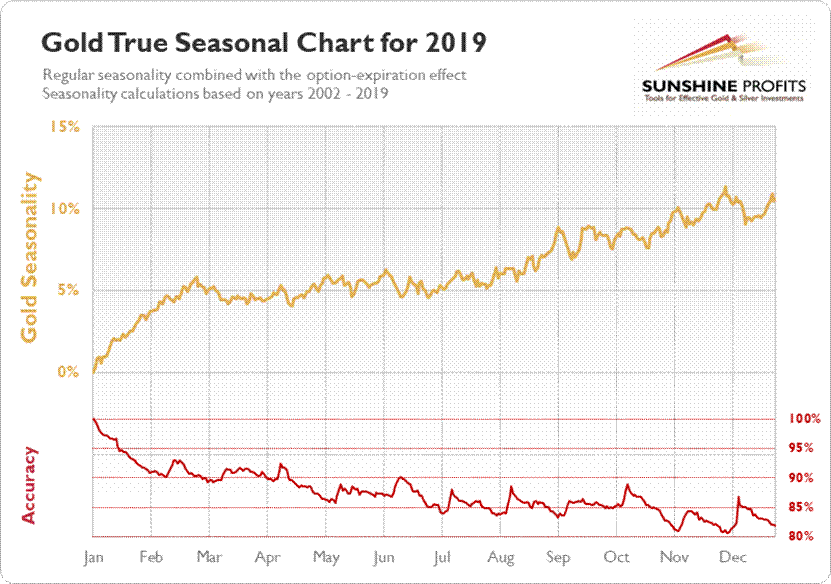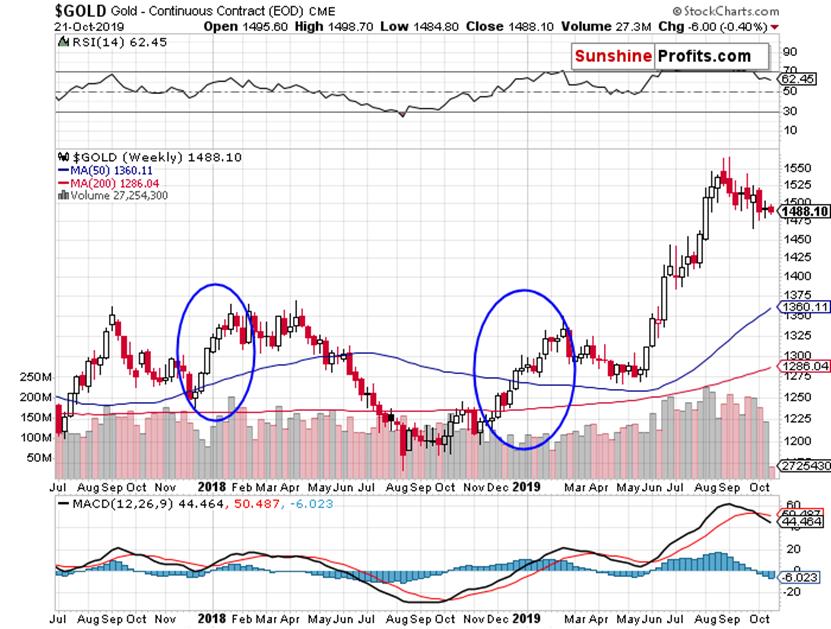Gold's Seasonal Outlook for Q4 / Commodities / Gold & Silver 2019
 “What is thebest predictor of future behavior? Past behavior.” And while this certainlydoes not always hold, there is a lesson to be learned from this adage for goldinvestors. Yup, a saying about behavior might be important for the preciousmetals market. The basic idea is that behavior can be understood as historyhere. And so, the best predictor of future developments could be pastdevelopments. In other words, past developments might hold some indications asto the fluctuations in the market.
“What is thebest predictor of future behavior? Past behavior.” And while this certainlydoes not always hold, there is a lesson to be learned from this adage for goldinvestors. Yup, a saying about behavior might be important for the preciousmetals market. The basic idea is that behavior can be understood as historyhere. And so, the best predictor of future developments could be pastdevelopments. In other words, past developments might hold some indications asto the fluctuations in the market.
In particular,market patterns might repeat over time. It might just as well be the case thatinvestors behave in a similar manner during specific times in the year. Oneclassic example is the period after New Year – it has been argued that theinvestors are optimistic at the beginning of the year and that markets couldrally then. Another one are the summer doldrums – the old saying is “sell inMay and go away” - meaning that people tend to tune out during the summer holidaysmore than at other times throughout the year. New Year and the summer do notmove throughout the year. But Thanksgiving does – it is not always on the sameday. The same goes for the market. Some influences could be difficult to pinpoint. The one we focus on isthe expiration of derivatives. Futures contracts and options do not alwaysexpire on the same day in the month. And so to account for them is slightlymore complicated. Even more so if you would like to combine classic seasonalpatterns with the expiration of derivatives.
HowSeasonality Fits in with Your Investment Process?
Fortunately, wehave been able to combine simple seasonality and the impact of derivativesin one form of analysis. So you do not have to pore over hundreds of charts andtry to figure out how all the pieces of the seasonality puzzle fit together.And so, you could boost you investment process with the use of our free GoldSeasonality charts.
The main thingto remember about the seasonal charts is that they are a great way to supportyour investment decisions but they do not replace other forms of analysis. Theway to use seasonal charts is to strengthen your trading signals. Anotherpotential use could be to guide you in periods where there are no clearindications from other sources. Seasonality can be useful on its own, but it isat its most useful when combined with other indicators. We highlight the maintenets of the seasonality charts in our seasonalityreport.
GoldSeasonality
Enough about what seasonality isand how it can boost investments. Let’s get down to the nitty-gritty of thecharts. Traditional seasonality calculations are based on the 2002-2019 windowand they are augmented by including the expirationof options for the years 2009-2018. The yearly chart is the first one we would like tolook at.

The first thing to notice on thechart is that gold tends to go up quite strongly and with relatively littlechoppiness in the first two months of the year. This fits in quite well withthe “January story” but if you take a look at the end of the year, you willnotice that the move up actually starts in December, not January, so it mightbe beneficial to consider a “December-February story.”
The general second point is thatstarting in late February, the appreciation tends to wane, giving way to aprolonged period of a more choppy nature. This period encompasses June andJuly, which gives some credit to the “sell in May” story, but the market tendsto take off in August rather than September. And so, the summer doldrumsmight be shorter than commonly believed.
The third phase is theappreciation in the August December period. The market tends to go up but themoves are a lot more volatile than is the case withthe early-year appreciation.
This is a relatively wideperspective and it might be interesting to see how it actually played out thisyear. Please keep in mind that the analogies do not have to perfect – nothingin the markets really is. Let’s take a look at the gold chart for 2018 and 2019(weekly chart courtesy of http://stockcharts.com).

We first call your attention tothe turn-of-the year periods. These periods for 2017/18 and 2018/19 are markedwith blue ellipses on the chart. As you can see, these are both periods ofsignificant rallies, quite in line with the “December-March” story. Actually,both these periods of appreciation end earlier than would be suggested byseasonality alone but seasonality would have given you quite a nice roadmapto potential market conditions. In particular, it could have strengthenedthe bullish indications of other forms of analysis.
This was the analogy on theannual time scale. However, in present market conditions, you are probably mostinterested in what seasonality can tell you now. So, the seasonality chart forQ4 is the one you would be interested in.

The above chart shows that inOctober gold tends to go up and down a bit, with a pronounced bounce in themiddle. And this is approximately what happened in October. The chart alsoshows that gold could be moving higher in November but the move looks quitechoppy. This is the part where it is particularly important to reconcile theindications of seasonality with the indications of of other indicators. This isprecisely what we do in our GoldTrading Alerts. Currently, it seems that the indications of seasonality weaken thebearish outlook but not to the point of making the outlook neutral, let alonebullish. Additionally, the seasonality suggests a potential sizablecorrection in late November/early December. This also suggests that onemight want to hold off on bullish moves up at least until that moment. So,together with other market conditions, seasonality currently points to apotential move down in early December. The situation might change, and wemonitor market conditions. Stay tuned to our GoldTrading Alerts.
Thisconcludes our second analysis of current seasonal charts. We hope this helpsyou navigate the market and gain the necessary tools to become successful inthis space. You can also read our first seasonalchart analysis.
Wehope you have enjoyed this week’s discussion of TrueSeasonal trading and we invite you to experiment and make thesetendencies work for you – our Seasonality charts are freely available right onour website.
Weencourage you to sign up for our daily newsletter, too - it's free and if youdon't like it, you can unsubscribe with just 2 clicks. If you sign up today,you'll also get 7 days of free access to our premium daily Gold & SilverTrading Alerts. On top of that, you’ll also get 7 days of instant email notificationsthe moment a new Signal is posted, bringing our Day Trading Signals to yourfingertips. Sign up for thefree newsletter today!
Regards,
MikeMcAra
BitcoinTrading Strategist
Bitcoin Trading Alerts at SunshineProfits.com
Disclaimer
All essays, research and information found above represent analyses andopinions of Mike McAra and Sunshine Profits' associates only. As such, it mayprove wrong and be a subject to change without notice. Opinions and analyseswere based on data available to authors of respective essays at the time ofwriting. Although the information provided above is based on careful researchand sources that are believed to be accurate, Mike McAra and his associates donot guarantee the accuracy or thoroughness of the data or information reported.The opinions published above are neither an offer nor a recommendation topurchase or sell any securities. Mr. McAra is not a Registered SecuritiesAdvisor. By reading Mike McAra’s reports you fully agree that he will not beheld responsible or liable for any decisions you make regarding any informationprovided in these reports. Investing, trading and speculation in any financialmarkets may involve high risk of loss. Mike McAra, Sunshine Profits' employeesand affiliates as well as members of their families may have a short or longposition in any securities, including those mentioned in any of the reports oressays, and may make additional purchases and/or sales of those securitieswithout notice.
MikeMcAra Archive |
© 2005-2019 http://www.MarketOracle.co.uk - The Market Oracle is a FREE Daily Financial Markets Analysis & Forecasting online publication.
